For the last year, I’ve been playing and enjoying the game Assassin’s Creed Odyssey which is set in ancient Greece. The countries around the Mediterranean sea, eat a very different diet than we do in the Nordic countries, and that has always fascinated and inspired me. This is my recipe for delicious sourdough olive bread.
The bread has a healthy amount of Kalamata olives and is spiced with dried herbs that grow naturally in the region. We’re using basil, thyme, oregano, and rosemary.
If you are just here for the recipe, you can press the button underneath to be automagically transported to the recipe:
Jump to Recipe Jump to Video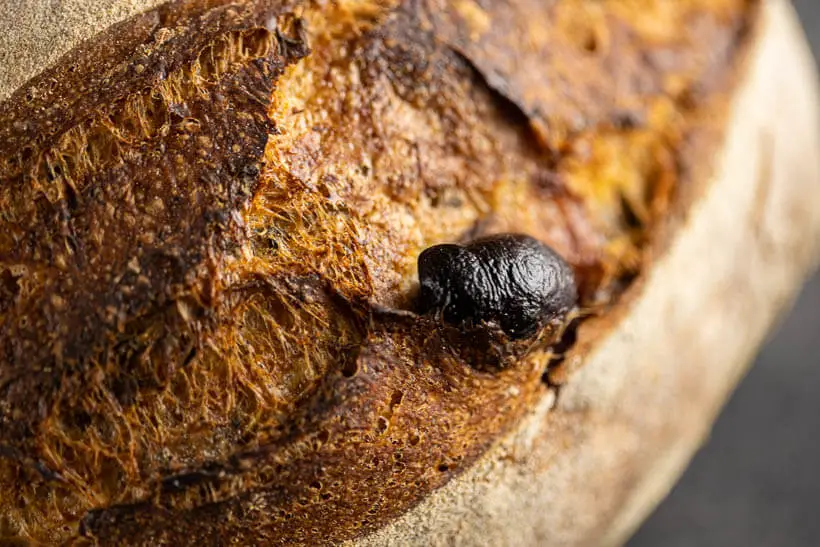
Higher hydration than before
This bread is a step up in hydration from my sourdough bread for beginners which has a hydration of 70%. That bread is a bit more forgiving if you don’t get the gluten all the way, but this higher hydration helps with getting bread that will stay fresh longer.
A breads hydration is the ratio of the total water in regards to the total flour in a percentage
I chose to raise the hydration by five percent. It seems like a good place to start, so this bread is made with 75% hydration.
The formula in this sourdough olive bread recipe
To make this sourdough olive bread recipe you need an active sourdough starter. If you don’t have one you can learn how to make one.
When you look at the table below, you may say that it says that the water is 62.3%, but you said that the hydration is 75%, but you have to remember to add the water and the flour from the levain.
The amount of starter that’s included in the dough is 250g. That means it contains 50g bread flour, 50g whole-grain wheat flour, 50g starter (which is 25g flour and 25g water), and 100g water.
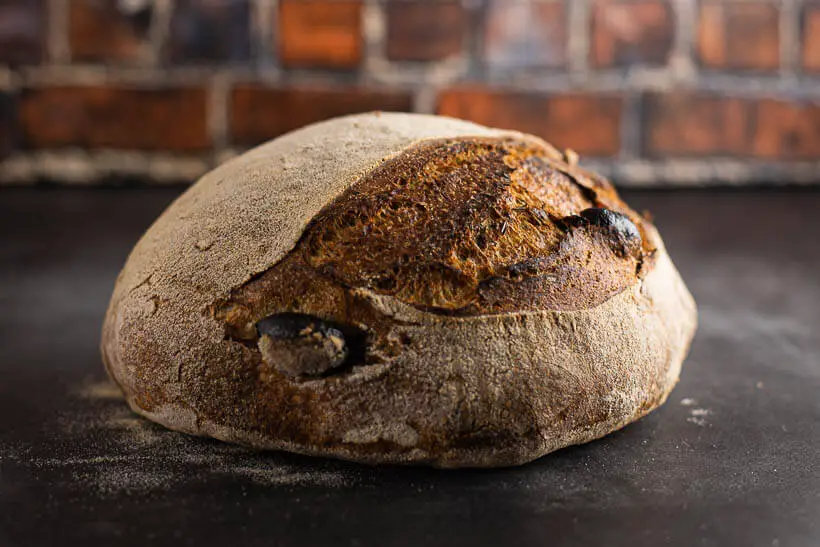
That brings the total flour weight up to 988g (704g + 159g + 50g + 50g + 25g) and the total water weight up to 741g (616g + 100g + 25 g).
Then we just divide the water weight by the flour weight and multiply by 100. Voila. 75%.
If you want to change the hydration, it can be done through my Bread Calculator.
| Weight | Ingredient | Baker's Percentage |
|---|---|---|
| 50g | bread flour | 50% |
| 50g | whole-grain wheat flour | 50% |
| 100g | water | 100% |
| 50g | starter (100% hydration) | 50% |
| Weight | Ingredient | Baker's Percentage |
|---|---|---|
| 704g | bread flour | 81.6% |
| 159g | whole-grain wheat flour | 18.4% |
| 616g | water | 71.4% |
| 21g | salt | 2.4% |
| 250g | olives | 29% |
| 0.5g | basil | ~0.06% |
| 0.3g | thyme | ~0.03% |
| 0.3g | rosemary | ~0.03% |
| 0.3g | oregano | ~0.03% |
What type of olives should I use in this sourdough olive bread recipe?
Culinarily there are three types of olives. They all come from the same tree, but it’s about when they are picked.
They are:
- Green olives – they are picked when the olive fruit has the right size, but before it ripens.
- Half-ripe olives – these olives have started the ripening process. The skin has started changing color, but the flesh is still green. The colors vary from green to several shades between red and brown.
- Black olives – fully ripened olives. Both the skin and the flesh are in the color nuances between brown and black.
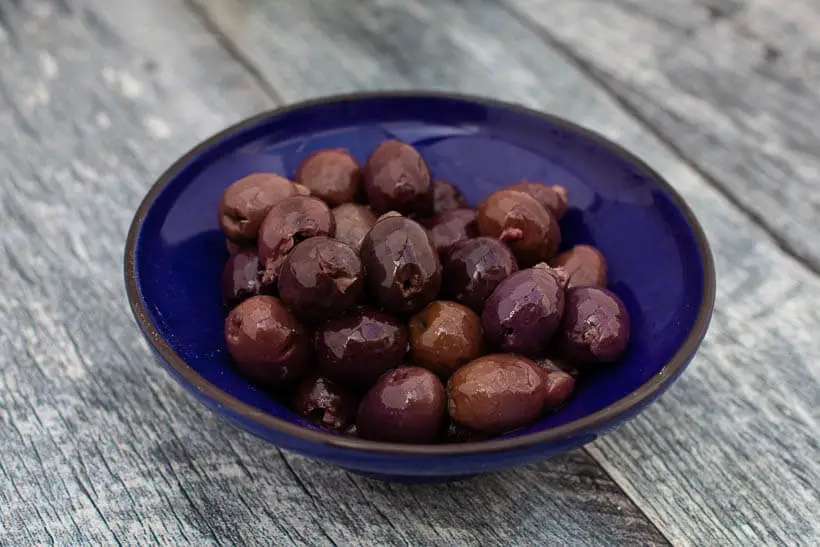
I chose some delicious black Kalamata olives that I brought from a specialty store in Copenhagen called “Stig’s Olives”. The best olives that you can find, it’ll make a difference in the final result.
Baking with steam
To give the bread a great oven spring you will need to bake the bread with steam.
There are several ways to do this:
- Use the steam function of your oven
- Use a pan with a rolled-up towel in the bottom of your oven while baking
- Bake the bread in a dutch oven or combo cooker.
Whatever way you choose to use, do not skip baking with steam. You won’t get the right result, but all of the above methods will give great results.
Conclusion
This sourdough olive bread recipe has relatively high hydration. Not so hard that it is impossible to work with the dough, but you need to know the techniques to get a good result.
The crumb is open and full of delicious olives. The herbs accentuate the Mediterranean vibe and perfectly suit the earthy notes from the olives.
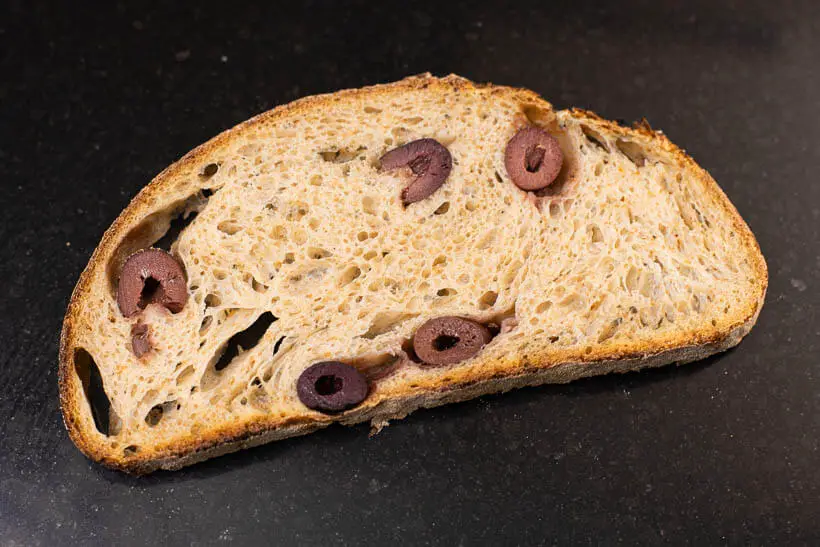
The crust is super crispy and has a fabulous smell. This is wonderful bread as a side for almost any Mediterranean dish and many dishes in middle eastern cuisine.
It’s a fabulous bread. I hope you’ll try to make it.
Please share on social media
This is my recipe for sourdough olive bread. I hope you will try to make it.
If you make it and post it on Instagram, please tag me as @foodgeek.dk so I can see what you made. That would make me very happy.
Ad links! Links for equipment and ingredients in this recipe are affiliate links, which means I will get a commission if you purchase the product!
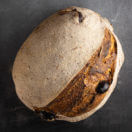
Sourdough Olive Bread
Ingredients
The dough
- 704 g bread flour
- 159 g whole wheat flour
- 250 g sourdough starter fed and grown to its peak
- 616 g water
- 21 g salt
Extras
- 250 g kalamata olives
- 2 teaspoon dried basil
- 1 teaspoon dried thyme
- 1 teaspoon dried oregano
- 1 teaspoon dried rosemary
Instructions
Mix the dough
- Mix everything for the dough into a shaggy dough. Cover it, and leave it to develop the gluten for one hour.
Bulk fermentation
- At the beginning of the bulk fermentation, you should do three sets of stretch and folds every 30 minutes.
- Do a set the following way:
- Wet your hands. Grab the dough in the back of the dough, and stretch it upwards as far as it goes without breaking.
- Fold the dough down towards yourself. Turn the bowl a quarter turn and repeat.
- Do two more so that you've stretched and folded the dough from all four sides. During the second set of stretch and fold, add ¼ of the olives before doing the stretch and fold.
- Then add a quarter more of the olives for each stretch and fold until you've added all of the olives to the dough.
- After the last stretch and fold, do a windowpane test to see if the gluten development is good. If not, add one more set and then move on.
- Leave the dough covered by a damp dishtowel for 3-4 hours until it's grown 30-40%.
Dividing & pre-shaping
- Pour the dough onto your unfloured kitchen counter and divide it into two using your bench scraper. I usually weigh the dough, but you don't have to.
- Take one piece of dough and flip it over. We are going to work some strength into the surface of the dough.
- Grab the bottom of the dough (closest to you), stretch it up, and fold it halfway over the dough.
- Continue with the right side, the left side, and the top of the dough. It should resemble an envelope.
- Flip the dough over so that the part against the table is now facing up.
- Put your bench scraper behind the dough and pull it forward so that the top of the dough is drawn in under the front of the dough, thus tightening the top.
- If an olive pops out of the dough, don't push it in. Either remove it entirely or add it to the back of the dough.
- Put the scraper in the front of the dough and push forward and turn the dough so that the scraper is behind again.
- Keep going until the dough is a pretty nice ball.
- Leave both dough pieces to rest for about 20 minutes to relax the gluten.
Shaping the dough
- Flour two oval bannetons
- Put a little bit of flour on your kitchen counter. Flip a piece of the dough onto the flour.
- Put it out into a rectangle. Stretch one side out and fold it over the dough. Repeat with the other side.
- Roll the dough up tightly. Roll the seam downwards toward the table.
- Seal the ends by pulling the dough on the side down over the roll on the side
- Put the shaped bread in an oval banneton with the seam upwards and put it in a plastic bag so that the dough doesn't dry out.
- Shape the other bread.
Final proof
- Then you need to do the final proof. You can choose to bake the same day and let the dough proof on the kitchen counter, or you can put it in the fridge and do an overnight proof.
- If you let it proof on the counter, you can check if the dough is ready to bake using the poke test.
- Poke the dough lightly with your index finger. If the hole fills in quickly it needs to proof more, if the hole fills slowly and leaves a slight indentation it is ready. If the hole doesn't fill the bread is over-proofed. Bake immediately.
Baking
- Put a dutch oven or combo cooker in the oven and heat your oven to 230°C/450°F/Gas mark 8. Let it heat for half an hour.
- If you opt not to use a dutch oven or combo cooker, you must steam the bread using other methods. If you bake steamed, you should use a baking stone or steel, and you can bake both loaves simultaneously.
- Bake covered (or with steam) for 20 minutes. Remove the lid or vent the steam.
- Bake for another 25 minutes until the bread is crusty, crunchy, and has a dark caramelized crust. If the bread does not look done once the 25 minutes are up, use your baker's intuition and keep it in until it's done.
- Bake the other bread the same way.



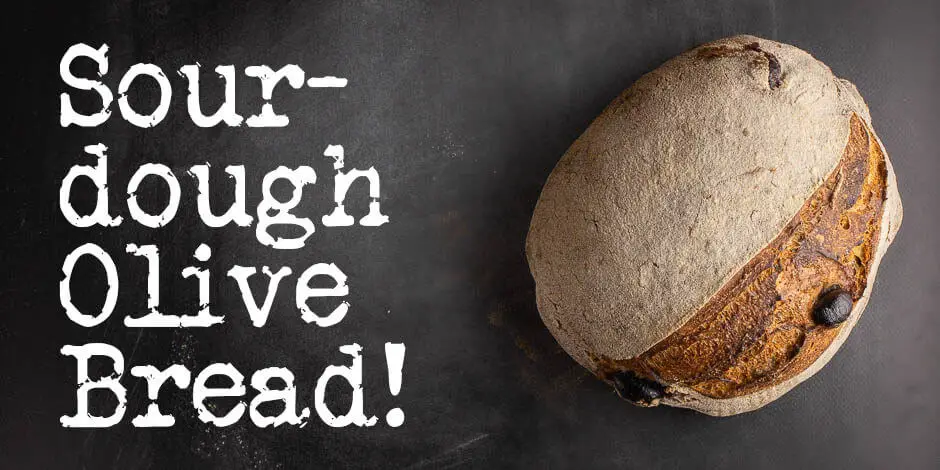


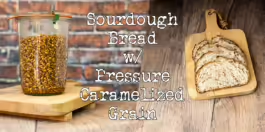




If 1/4 of the olives are added during the 2nd Stretch & Fold, when are the other 3/4 of the olives added? During each of the following S & F’s?
Thanks, this looks very delicious.
I updated the recipe. They all need to be added during the second set, just 1/4 with each individual stretch and fold 🙂
Hi! The recipe says to add all the spices to the Autolyse (step 1) but then on Bulk Fermentation (step 7) it again says you need to add the spices. In the video you add them during the stretch and folds but I added them to the autolyse. Will it be a problem?
No, adding them in the autolyse is better because they get dispersed more. That’s why I changed it (but I guess not completely) 🙂
Can I simply cut the ingredients in half so I don’t have to bake two loaves?
Absolutely 🙂
Hi! I think it may work better with a different type of olive. The skins on Kalamata olives are very smooth. Italian dry black olives may work better for this bread as they are more textured and would merge better with the dough. I will have to try that, maybe this weekend and see how it comes out. Thank you for doing all you do, your videos and website are an amazing resource. 🙂
Carey
Thank you <3
I just love the taste of kalamata, but your point is taken 🙂
“Black olives” are not ripe olives. They are made by picking olives still green from the tree, and putting them through a different fermentation process which turns them black.
if you pick ripe olives from the tree, when they have turned black naturally, they lighten during processing to become the grey, brown or purple mid-colour olives. You called them “half-ripe” olives, but actually they are fully ripe olives. Kalamata olives are often of this type.
Sun-dried olives are the only naturally fully black olives, but they are quite rare, not the normal black olive.
just made it.
Thanks for sharing..
I had a problem with it being too sticky and not passing the stretch window test.
moved forward and it had not enough consistency to get the shape and be manipulated after the 3/4 hour growing.
=(
Going to oven in 20min. Lets see
If you mail me (use the contact form) exactly what you did and what kind of flour you used, I’ll help you troubleshoot it 🙂
I tried to make this today. It’s a great recipe. I’m a relative beginner with sourdough but have had some success. One thing you don’t mention is with the three stretch and folds, I now realise I think we are supposed to wait 30 minutes in between each set. You mention that in conjunction with extra sets in addition to the three. But not with regards to the first three. I have a feeling this is why my dough doesn’t hold shape. Do you think this is correct?
I guess we live and learn.
I made this sourdough and it was absolutely delicious! This was my third time using one of your ingenious recipes. Please make a potato sourdough next 😊
My olive bread turned out beautifully, thank you Sune.
This bread was great. Wonderful. I couldn’t stop eating it just as it was.
I had only one problem. The dough doesn’t make a tight ball just before putting it in the refrigerator and doesn’t hold the round form once in the banneton. This happened in a previous bread so for this one I reduced water by 50 gr. But it wasn’t enough.
As it is with hydration, it’s different how much different flours can take. Use the link to the bread calculator and then change the hydration there. Go to 65% for starters.
Hi, I am new to sourdough and love your site. I’m wanting to make one loaf of the sweet blueberry bread and one loaf of the olive bread for a family member. Is it possible to do bulk fermentation together and then add the toppings separately? Or do I have to create two completely separate doughs? I only want one loaf of each, not two . Thanks.
I accidentally added all of the levain (300g instead of 250g) but it still turned out great. Thanks Sune!
What did you sprinkle on before baking, bread flour or rice flour? It was hard to tell and you didn’t mention it and it’s not in the recipe.
It’s white rice flour. It doesn’t scorch the way regular wheat flour does 🙂
Hi Sune, when you say, whole grain wheat flour- can I use whole wheat flour? or do you mean like whole grain (ex. spelt or rye)?
I mean a full extraction of wheat flour where nothing is sifted out. If your whole wheat flour is like that, then it’s good. You can use spelt, rye, or any other whole-grain flour too 🙂
Pingback: PCS Bakes! – The PCS Roar
Hi
For the version that I am looking at, the measurements for the Levain differ in the text from that noted in the recipe. The text notes 50 grams for each of the flours and starter ( the recipe notes 60 grams ) water is 100 Grams in the text and 120 in the recipe. I initiated my bake based on the text and then needed to figure out adjustments in the dough. Please consider an update for consistency. Thank you..
I did this on my earlier recipes because if you measured the levain, it would have less than needed, but I’ve just dropped the levain altogether now, so just use a peaked starter.
Would a Tablespoon of olive oil add flavor? From your other videos it will apparently soften the crust. Cheers.
It would soften the crust. Someone suggested to me to use olive brine in the dough, replacing some of the water. You’d have to remove the salt though or else it would get very salty.
are we supposed to autolyse the whole time the leaven is rising (up to 12 hrs? or can we do the usual 30-60 min?
The levain is supposed to take around 4 hours to double. It’s a 1:2:2.
You can do a 30 minute autolyse for sure 🙂
Thank you Sune – this is our favorite sourdough loaf and it comes out perfect every time. I love your attention to detail, which is key to making good bread. I wish I could add a photo of my bread here as it looks exactly like yours. You are awesome!
Thank you <3
Dear Sune,
First thank you for everything. I’m a COVID baker and your site and videos have transformed me into a serious sourdough artisan baker. As a geek myself (biotech industry), I really appreciate your application of the scientific method. I would have saved 5 months getting up to speed if I’d found you sooner. But bottom line, with your help I’m making the best bread I’ve ever eaten. And that’s saying a lot since I’m from the San Francisco/Berkeley/Napa area where this stuff is taken very seriously!
Second, with respect to this recipe, I’m not quite clear how much of the various herbs you are using and whether they are fresh or dried. Zero grams comes up for some, or 0.1g for others, when I use the bread calculator. The “card” however uses teaspoons, but doesn’t mention dried or fresh. Not that I couldn’t figure out a useable amount, but you’ve got a good touch so I’d like to see what you’ve settled upon.
Cheers,
Robert
You are welcome. I love to hear when my content makes a difference 🙂
I’ve updated the recipe and other places. The correct amounts were already listed in the recipe. 2 tsp basil and 1 tsp of the other spices. I used dried spices, which I’ve also updated the recipe to reflect.
Sune
I halved the recipe as I only have 1 oval banneton and limited space in my fridge for the overnight proofing. Baked this morning and was very happy with the result oven spring and crumb….AND taste. Took alot of patience to wait for it to cool.
Thank you <3
Yes, it’s a wonderful bread. I should make it again soon.
This looks delicious! Is it ok to use 20% innoculation and also 25% rise for the bulk fermentation? Also will it make any difference if I chop the olives a bit before including them? Thank you!
It should be fine using 20% inoculation and 25% rise 🙂
Chopped olives will give better dispersion, so go crazy 🙂
Sune:
I love this bread recipe and make it with not only olives and herbs but also other additions. Today I decided to make my own take on Prosciutto Bread using very smokey ham (Westphalian) from my local German Butcher. For the olives I substituted 250 grams of ham, 1/8″ thick (3 mm) and cut into 1/4″ (6 mm) squares. I also added I tsp of fresh English Thyme. As the ham is very salty I reduced the amount of added salt to 15 grams.The result was fantastic! The entire loaf takes on the smokey flavor of the ham and the house smells like fried bacon!
That sounds absolutely spectacular 😀